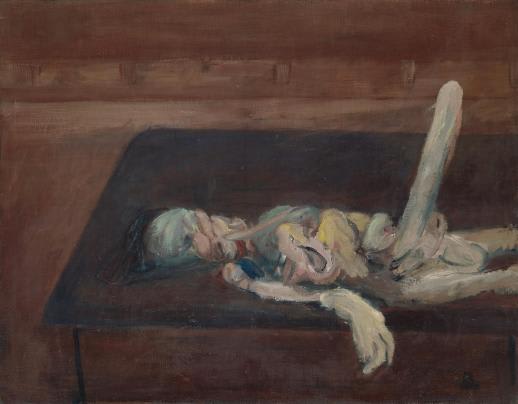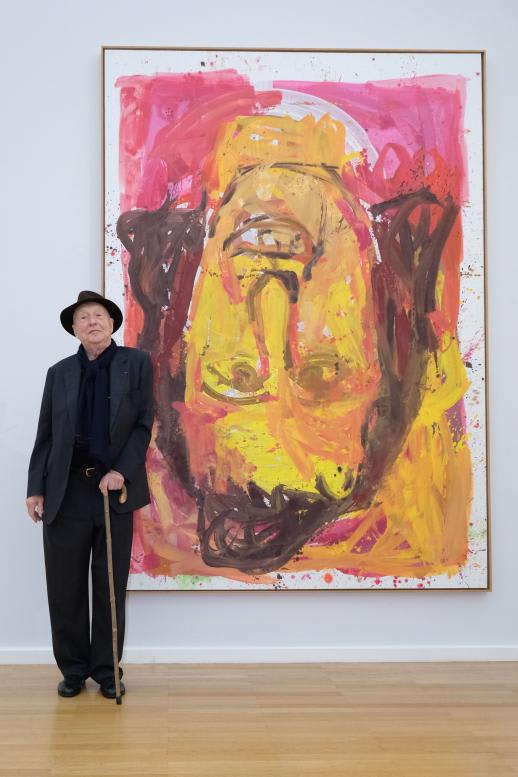
Mr Topsy Turvy: Is Baselitz the most controversial living artist?

As his wild upside-down paintings go on display in London, Georg Baselitz, 80, invites Oliver Moody into his studio to discuss Nazi nostalgia, penises and the need for aggression
One of Georg Baselitz’s fondest memories is of putting on his father’s Wehrmacht cap in the last years of the Second World War. “I was seven or eight, I was a child and I thought it was great,” he says. “I was kitted out with every weapon you can imagine. All the soldiers were my friends. That was my world. And then my world collapsed. Everything collapsed. My father came home like this” — he bows his head — “and everything was broken.”
Baselitz is 80. He is one of Europe’s best-known painters. He has watched the Third Reich disintegrate and another dictatorship take its place, abandoned East Germany for the West, torn through the art market and carried off its spoils like Genghis Khan on a bender, offended half of the intelligentsia by declaring that women cannot paint, then offended the other half by seeming to endorse the German far right and Donald Trump’s Mexican wall.
Baselitz is what is known in German as a Grenzgänger: a crosser of borders. A transgressor. An outcast. Out of the smashed landscape of his childhood he has built a career of contrariness, discomfort and suspicion of any stripe of authority. He never quite fits.
In 1959 he was chucked out of art school in communist East Berlin for “socio-political unripeness” because he did not fancy spending a year in a brown coal mine to “learn the world of work”. “Certainly, it’s a very good idea, but for an artist it is simply an annihilation,” Baselitz says. “When you have to do hard labour all on your own and only hang out with proles and can’t read a book and so on, you simply become stupid.”
And so, two years before the wall was built, he went for a stroll and wound up in the land of the fascist exploitation of the working masses. At least they had Willem de Kooning and Jackson Pollock. Four years later he had the succès de scandale that laid the foundations of the Baselitz myth. A man lies supine on a low table, his body apparently made of nothing but haphazardly arranged and greying internal organs. The only thing alive about him is a throbbing ramrod of a penis, easily the length of his torso, rising up to climax in a splendid orb of white light like the Saturn V rocket.
It was called The Naked Man and the German press hated it. The West Berlin authorities briefly toyed with the idea of charging Baselitz with making pornography. His reputation as an enfant terrible was secure, but more than half a century has passed since then. What do enfants terribles do when they grow old? It cannot be much fun being a vieillard terrible.
Oh, but it is. Baselitz has built himself a house on the northern bank of the Ammersee, a lake about 45 minutes’ drive to the west of Munich. It has a spectacular circular library with a spiral staircase snaking up the wall, half-hidden by shelving and illuminated by a huge hedgehog of electric lights pilfered from some English municipal council in the Sixties. In the next room there is a wall covered in black-and-white photographs of naked women.
There is another wall of framed newspaper photographs of women doing funny things in groups. Baselitz seems to have a particular liking for goose-stepping North Korean servicewomen. Lunch is served at one end of a long wooden table. It is weisswurst, a kind of pallid boiled sausage that looks like something from a pathologist’s unconscious mind, with roast pork, rough brown bread, sweet Bavarian mustard and riesling, which Baselitz liberally dilutes with sparkling water.
The artist is preparing for a retrospective of his works from the Eighties, the decade in which he broke into the American mainstream with a string of violent, expressionist paintings that one German art critic indelibly described as a “primal stream of oil”. They are marked out by their fierce contrasts of colour and playfulness with the human form. In one self-portrait he gave himself a large, bouncing pair of bosoms. In another image his wife, Elke, one of his recurring subjects, emerges like an immemorial shrunken head from a stabby thicket of red and black strokes.
“I think it redefined him and made him enter the public imagination,” says Thaddaeus Ropac, the Austrian gallerist who is curating the show in London. “He took America by storm. He really freed himself in this period. The brushstrokes became wilder, more aggressive. In the Eighties he was a mature painter. He had at last put all of this sturm und drang behind him. He knew absolutely what he was doing.”
The decade opened with an infamous joint exhibition at the Venice Biennale alongside Anselm Kiefer, another great postwar German artist who has wrestled with his country’s troubled history. Baselitz ran into an immediate controversy. He had just started experimenting with sculpture and hacked out of plywood a stern African tribal figure with its right arm raised in what looked to some weary eyes very much like a Hitler salute. Surely he saw it all coming?
“Perhaps that would have been pretty good,” Baselitz says, “but I’m so German that I didn’t even have to think of it and it happened anyway. That’s much better. This German pavilion, as everyone always said, the architecture was fascist and they should have torn it down. The artists who came before me were mostly sculptors. [Joseph] Beuys came right before me.
“And so I thought, ‘Now I have to make a sculpture.’ Naturally it didn’t turn out to be a very lovely thing. It was something crude and clumsy and perhaps a bit moronic too, but it was aggressive, and that is really important. Then there was all this criticism from Germany, and they played the Horst-Wessel-Lied[a Nazi party anthem] whenever you saw it on the television.”
In some ways you could call Baselitz the David Bowie of visual art. There is the same magnetic aura of novelty. There is the same nose for trouble and shocking people just enough to make them pay attention. There is the same habit of learning a new trick more or less once a decade. In the early Sixties it was the willies. In 1969 it was the habit of hanging his paintings upside down, which stuck with him through the rest of his career. In the Seventies it was giant canvases and splintery sculptures. In the Nineties it was the demarcation of his figures with slender, fussy black lines sketched out with a reed brush.
Baselitz is a proper craftsman. He is monkishly fixated on the technicalities of his trade. He admires the younger generation of artists as much for their skill as for their knack of promoting themselves through social media. One day some Dutch friends of his happened to mention that they had seen Tracey Emin on television. She said that when she was starting out she had wanted to marry Baselitz and would have dragged him to the register office if she could.
“It was so funny that I bought myself Tracey Emin’s book, her memoirs I suppose you could call them,” he says. “I found it very interesting and then we met many times in London. There’s the language barrier, but in this case it’s no great barrier. She is a very eloquent, and of course very funny, but also a very aggressive person and I think that what she does has substance.”
A cynic would say — and plenty have — that Baselitz is a gimmick merchant. That he is shallow and unscrupulous, an insider’s outsider. The public galleries in Germany may show astonishingly little of his work, but he has become a figure of national importance and an exceedingly wealthy man. Gerhard Schröder, the chancellor who devised the modern German welfare state, hung one of Baselitz’s upside-down eagles in his office. Deutsche Bank is among his keenest customers. His exhibitions have been sponsored by Hugo Boss. Baselitz has a very postmodern genius for seeming utterly contemptuous of money and approval while raking in both commodities like a Roman emperor.
Yet none of this is quite right. Baselitz draws on a deep well of principles. If he has one defining idea it is that resistance, as he puts it, “is simply the prerequisite of every artist”. Nothing new or interesting can come of respecting the pieties of the age. So you must break them.
Democracy, for example, has become a “totally vague, undefined catchphrase”, he says. “Last week the German parliament brought in a new law [to recognise] the third sex,” Baselitz says. “There is no third sex. Unless you mean children, but that’s not what they mean. Just the 0.0001 per cent who say, ‘Oh, we’re hermaphrodites’, count as a third sex. This term ‘democracy’, if it’s left unanalysed, is not enough. In this time we have no democracy and, if you consider it a little, we have an autocracy. We have autocrats who exercise mastery over the population.”
A more charitable reading of Baselitz’s career would be that has been fighting so hard for so long that he has forgotten how to do anything else. Yet he is also intensely sensitive to criticism and always surprised when it crops up. He wears provocation and contrariness in much the same way a hermit crab wears its shell. He cannot even answer a simple question about the liberal consensus without pushing back (“Now they’re introducing a quota for women in politics, which is more or less the most stupid thing you can imagine”). He is drawn to taboo subjects and easily bored by commonplaces, a fateful combination in the early 21st century.
After lunch is over, there are a few minutes left to look around Baselitz’s studio. It turns out to be an enormous, whitewashed barn. One side of its roof is dominated by a window that must be the absolute mother of devils to clean. The other is a bank of white neon striplights.
In the middle of the floor is a large unstretched canvas, laid out flat. Every day the old man gets down on his hands and knees and works for hours, with quick, precise, decisive strokes. At the moment he is doing versions of self-portraits by his favourite artists. They live somewhere in between the worlds of the living and the dead.
The series is called Devotion. There is a naked Emin, hunched over into a craggy triangle. Frank Auerbach and Henri Rousseau are like ghostly pickled vegetables against their dark backgrounds, shimmering in luminous clouds of dust. And there, descending a flight of spectral stairs, all knobbly knees and latent energy, is Baselitz himself. Between his legs there still hangs a massive, obtrusive penis.
Georg Baselitz: A Focus on the 1980s is at Galerie Thaddaeus Ropac, Ely House, 37 Dover Street, London W1 to November 21, 020 3813 8400, ropac.net

The Naked Man, 1962


Drinker + Bottle, 1981



Tracey Emin and Georg Baselitz at the Royal Academy in 2007